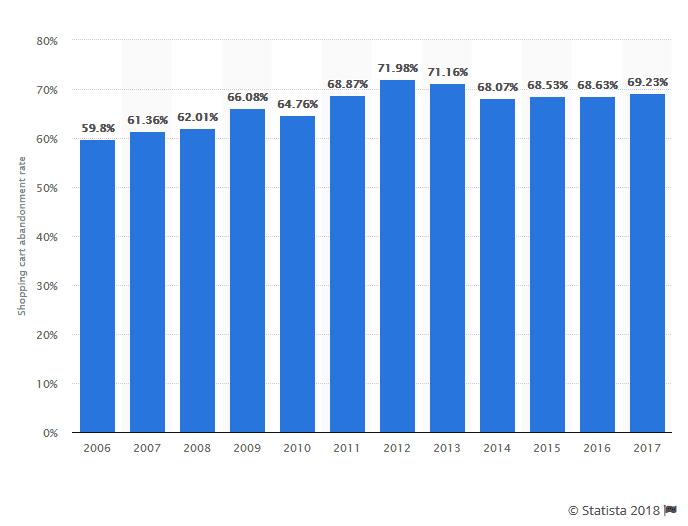
As its name implies, shopping cart abandonment is when a user adds one more or products in the e-shopping cart, and they don’t carry on to the purchase.
The metric that measures the shopping cart abandonment is called “abandonment rate”, and you can calculate it using this formula:
Cart Abandonment Rate = (Transactions Initiated – Transactions Completed) / Transactions Initiated
So has Cart Abandonment always been like this?
With one word – Yes. Cart abandonment is a thing since the dawn of eCommerce, and its rate is 10% higher than it was 10 years ago.
But is your cart abandonment high or low?
Shopping cart abandonment differs from industry to industry.
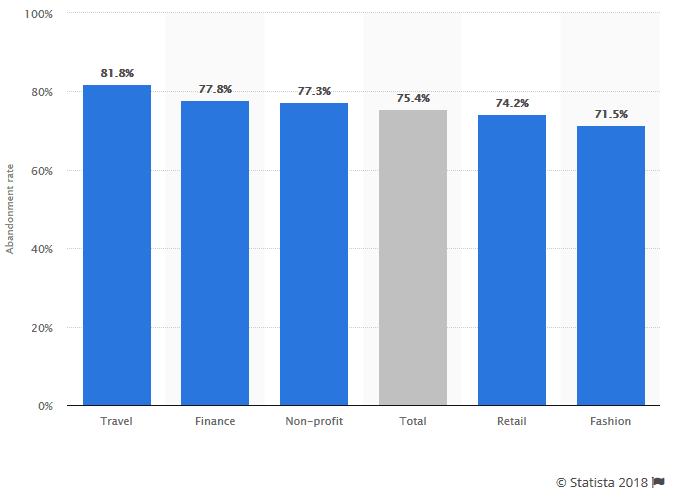
It looks like it’s easier to find a cheaper flight but harder to say no to a new pair of shoes. You never have enough shoes anyway, am I right?
Most statistics agree: Global cart abandonment is around 75%.
So what are most frequent reasons that lead to cart abandonment and what can you do about it?
Cart Abandonment Reason #1: Shipping Cost
There are many reasons a customer might abandon their cart, but this one takes the cake.
Shipping cost is by far the #1 reason that prevents your customers from completing their purchase. More than half carts are abandoned due to the extra cost, which is usually shipping cost, but it also can be tax and fees as well. There are dozens of different currencies around the world, but all customers agree: Hidden costs suck! Hidden costs annoy them, irritate them and make them feel stupid.
Shipping cost causes cart abandonment through multiple ways: In most cases, the added cost of shipping that customers don’t see until the end of their purchase journey caught them by surprise.
In other cases, customers abandon their carts because their total purchase wouldn’t reach the minimum amount to qualify for free shipping.
– Solution
Since shipping is the most significant factor in cart abandonment, it should be your #1 priority in the no-purchase battle. If you see a high number of abandoned carts on your eCommerce store, here’s what you should do:
Leave no hidden cost for the last purchase tab. State all costs from the outset. Be 100% transparent. Transparency as a value is highly appreciated by most consumers and is crucial for your store success. Eliminate every surprise. Learn from the best – ask yourself: what would Amazon do?
Let’s say I want to purchase this pair of Sony headphones from London; it will cost me £80. Also, I don’t have to pay anything for shipping, as Amazon is letting me know what deliveries within the UK borders are free. On the other hand, things change if I want to buy from Athens because in this case, free shipping is not a thing anymore. What’s important here though is that Amazon lets you know it’s not. Not only that, but it also breaks down the shipping cost and provides extra info regarding the total cost. Furthermore, I can see the total purchase cost, as the sum of Product + Shipping.

Is by any chance tipping the courier mandatory by law in your country? Then say it!
Coming in second, offer more than one shipping carriers.
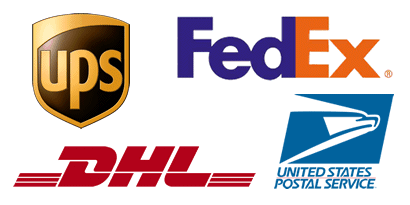
Delivery is a very demanding and highly competitive industry to be in. One single mistake on the delivery company’s part can ruin customer experience and make the customer never to want to trust this company again. If the customer has had a bad experience with the one shipping carrier you collaborate with, then in a certain way, you force them to reject your product as well.
Apart from providing more shipping carriers to choose from, you should also –
Give more shipping options, including delivery speed and rates. This choice, of course, will overlap the choice of any carrier.
Offer them free shipping. For this strategy to be profitable, you can either:
Include the shipping price in the final price.

Or offer Free Shipping when customers order over a certain amount.
This common tactic not only reduces your cart abandonment rate, but it also increases your average order value (AOV).
Entice your shopper to add a few more items in their cart by offering them free shipping over a certain amount.

Cart Abandonment Reason #2: No Guest Checkout
So, your customer did their research, browsed your store, decided what they want to buy, added everything they wanted, and now they are absolutely ready to give you their hard-earned money. For some reason though, you’d rather take their address than their money. Why?!
Unless you believe postal codes can be a valid currency in any sort of market, you should stop bothering your customers with questions regarding their profile.
Profiling your customers is vital for your marketing strategies, alright. But you should not prioritise some data over a purchase. You can always ask for more data at the end of the checkout process.
– Solution
Enable guest checkout. Unless you own some kind of elitist members-only only club, you shouldn’t close your e-store door to non-members. Imagine a brick and mortar shop. Do you have to be a member to shop from your local grocery stores? Being a member usually comes with benefits, but it’s not mandatory if you want to buy a bag of tomatoes and lettuce.
Enabling guest checkout might be easier than you think.
This is how you can enable guest checkout on WooCommerce:
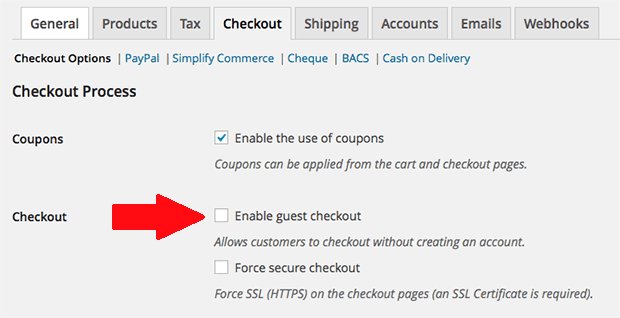
And this is how you do it on Shopify:
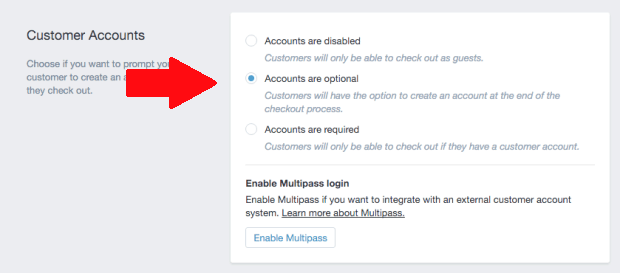
Cart Abandonment Reason #3: Complicated Checkout Process
This one is similar to the lack of guest checkout option, but it’s not the same. A complicated checkout process is about when the checkout process takes more than it should.
Every form field you ask is one more obstacle between your customer and the finish line.
If you had to take only one piece of information, that should be your potential shoppers’ email. Making anything else a priority is just a bad idea at this point.
The email address of your customer is digital gold. It’s about opening a direct channel between them and you.
– Solution
Only ask for necessary information.
Additionally, streamline your site’s navigation. Reducing the “number of screens” from initiation to completion is a great way to reduce time.
Show the steps your customer will have to make to the checkout and let them know where they are at. You can write it, e.g. “Step 2 of 4”, or show it like here…


… or even better, do both.
Can you do what Dribble, the popular designer community, does when the time comes to ask for your money?
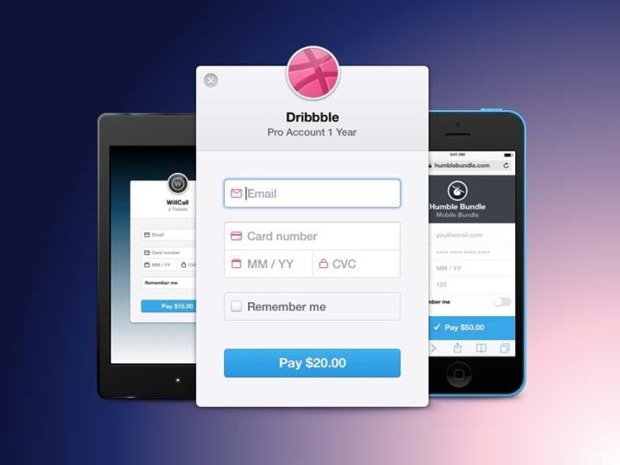
Well, then, good for you!
The fewer things you ask, the higher the percentage for the customer to make it to the ‘I’m Giving Yoy My Money’ button.
In addition, you can pre-fill fields when(where)ever you can.
You don’t have to ask customers to fill out both a billing address and a shipping address when, more often than not, they are identical. Instead, give them a simple check box that customers can click so that the billing address fields are filled out with the information from the shipping address fields.
Also, asking for their zip code should automatically pre-fill other forms like region, city and state. Let those fields be editable, though, in case your customer wants to make any changes regarding this info.
Cart Abandonment Reason #4: Payment Security concerns
Long story short, I was searching for a particular (obscure) pair of shoes and found it on an eCommerce store. I hit ‘Add to Cart’ and went for the checkout. Now, I never had bought anything from that website before neither did I know or have heard the retailer’s name. So I wanted to make sure that everything is OK. The first thing my eyes do in situations like these is to look for the SSL certificate.

If you are new to the internets, an SSL (Secure Sockets Layer) certificate can be found in an address bar on the top of your browser. SSL is a method used to secure and encrypt sensitive information like credit cards, usernames, passwords, and other private data sent over the Internet. Website pages secured with SSL are those branded with the HTTPS in their URL address. Like the one, you are on right now! Now back to our story.
So I looked for a certificate, but there was none. Alarm #1 went off. I looked at the header and footer for an ‘About Us’ section. None. Alarm #2 went off. Then I visited the company’s Facebook page. 200 Likes. Alarm #3 went off, and at that point, I was sure the page was a scam. I would have to find the shoes elsewhere.
Keep note that I played Sherlock because I was looking for something that was hard to find. If I were looking for something more common, then the moment I would notice the absence of the green lock at the address bar, is the moment I’m leaving the site and look somewhere else.
What if your eCommerce store is 100% legit, but your customers bounce due to something as basic as an SSL certificate?
When it comes to your new customers, you have to earn their trust.
Lack of SSL certificate, missing images, design flaws, old layouts. All of these can be enough to scare a potential customer off – him and their $€¥.
– Solution
Get an SSL certificate. If you didn’t get it along with your domain purchase, you can add it anytime you want by visiting ssl.com.
Be as transparent as possible. Provide full contact information, such as a phone number and an address, besides your social media info.
Write an ‘About Us’ section. Truth is most customers don’t give a damn about who you are and what you’ve done. They are on your website for your stuff – not your character. Nevertheless, some of them will want to learn more about you to feel reassured or because they are just curious. You have to give them this option. Spend a few paragraphs to talk about your business and the people working for the firm.
Enable reviews. Allow your customers to talk in public about your products and services. And when the shit hit the fan, this is how you can deal with angry customers on social media. Again, it’s about transparency. Show your potential customers that you care about their opinion, no matter if it’s good or bad.
Fix every flaw you can find on your website. Check the copies, check the designs.
Cart Abandonment Reason #5: Not enough payment methods
Different customers prefer different payment methods. Customers expect multiple payment methods. For security reasons, many of your shoppers don’t want to use their credit or debit cards for their online reasons. They may prefer a different method. Here are the preferable payment methods in a few European countries:
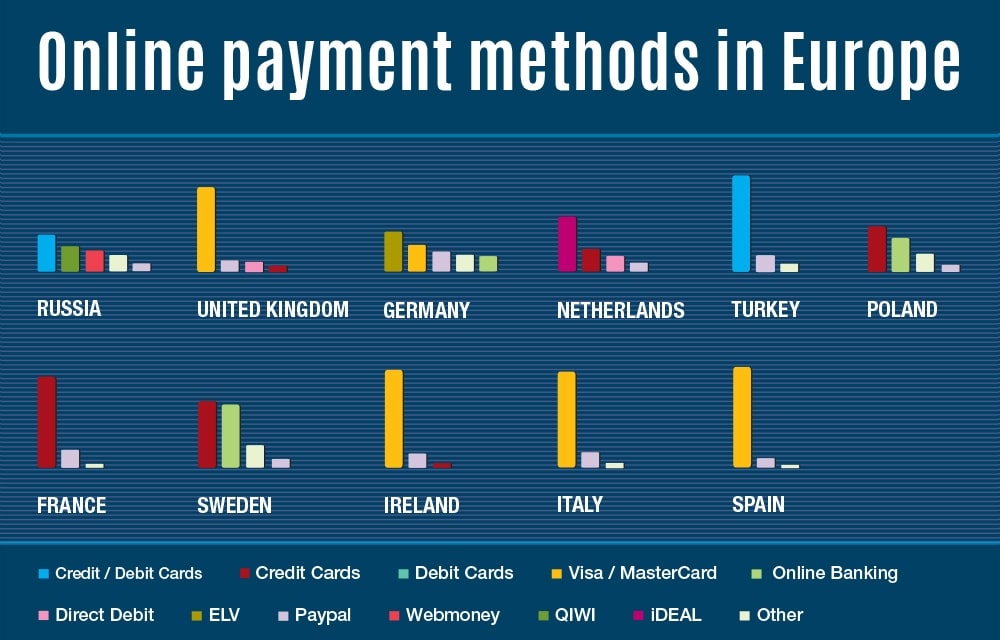
If you are Irish, but your e-business has a global audience, it doesn’t really matter if your fellow countrymen prefer debit card payments over Paypal.
In general, the more payment methods you give, the less cart abandonment you should expect.
– Solution
It comes as no surprise that the solution to not enough payment methods is more payment methods. Such methods include:
- Credit cards
- Debit cards
- Mobile payment apps
- Payment gateways
- Online banking
And while you’re at it, you can also include a money-back guarantee. A money-back guarantee creates trust and credibility for your product and your business. Protip: only a few customers ever return to ask for their money back.
Epilogue
To sum up, the Top 5 reasons for cart abandonment are:
1. Shipping cost
2. Lack of guest checkout option
3. Complicated checkout process
4. Payment security concern
5. Not enough payment methods
Abandoned carts can be seen as the extension of your customer service. In growth hacking, regarding a Growth Action Plan, cart abandonment is about Retention. Take the time to invest your cart abandonment rates.
The post The Top 5 Cart Abandonment Reasons – With Solutions appeared first on GrowthRocks.